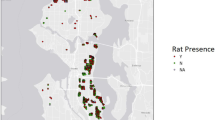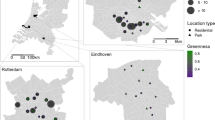Abstract
Norway rats are an important commensal species of human settlements. They are abundant in urban areas and generate several problems to our societies. Integrated rat management programs, based on detailed knowledge of its biology, are needed to keep rat populations under control. One of the main habitats of rats in cities is the sewer system. Unfortunately, very few studies have been conducted on sewer rats due to the logistic challenges of such projects. Hence, information on the ecology of rats in a key habitat, crucial to management programs, is scarce. The aim of this study is to estimate the abundance of Norway rats in the sewers of the city of Barcelona and determine the main related ecological factors. We sampled 63 sewer sections 90 m long during the study. We obtained several rat activity estimates, we compared them, we calculated a minimum rat density, and with that, we estimated the minimum rat population size in the sewer system of Barcelona. Bait consumption and rat capture estimates showed low correlations. Sewer rats showed the highest activity in areas with high density of housing and in old sections. The presence of natural soil favoured the activity of rats only inside the areas with a high density of housing. The activity of rats showed a high variability among sewer sections. The citizen complaints for rats, which were positively related to the human density and negatively related to the mean disposable household income, were bad predictors of the activity of rats in the sewer system.





Similar content being viewed by others
References
Almeida A, Corrigan R, Sarno R (2013) The economic impact of commensal rodents on small businesses in Manhattan's Chinatown: trends and possible causes. Suburb Sustain 1(1):2
Auerbach J (2014) Does New York City really have as many rats as people? Significance 11(4):22–27
Barnett SA, Bathard AH (1953) Population dynamics of sewer rats. J Hyg 51(4):483–491
Cavia R, Cueto GR, Suárez OV (2009) Changes in rodent communities according to the landscape structure in an urban ecosystem. Landsc Urban Plan 90(1):11–19
Cavia R, Cueto GR, Suárez OV (2012) Techniques to estimate abundance and monitoring rodent pests in urban environments. In: Soloneski S (ed) Integrated pest management and pest control—current and future tactics. IntechOpen, Berlin, pp 147–172
Channon D, Cole M, Cole L (2000) A long-term study of Rattus norvegicus in the London Borough of Enfield using baiting returns as an indicator of sewer population levels. Epidemiol Infect 125(2):441–445
Channon D, Channon E, Roberts T, Haines R (2006) Hotspots: are some areas of sewer network prone to re-infestation by rats (Rattus norvegicus) year after year? Epidemiol Infect 134(1):41–48
Childs JE, McLafferty SL, Sadek R, Miller GL, Khan AS, DuPree ER, Advani R, Glass GE (1998) Epidemiology of rodent bites and prediction of rat infestation in New York City. Am J Epidemiol 148(1):78–87
Colvin BA, Jackson WB (1999) Urban rodent control programs for the 21st century. In: Lahgr S, Liers H, Zhang Z (eds) Ecologically-based rodent management. Australian Centre for International Agricultural Research, Canberra, pp 243–257
de Masi E, Vilaça P, Razzolini MTP (2009) Environmental conditions and rodent infestation in Campo Limpo district, Sao Paulo municipality, Brazil. Int J Environ Health Res 19(1):1–16
Easterbrook JD, Shields T, Klein SL, Glass GE (2005) Norway rat population in Baltimore, Maryland, 2004. Vector Borne Zoonot 5(3):296–299
Feng AYT, Himsworth CG (2014) The secret life of the city rat: a review of the ecology of urban Norway and black rats (Rattus norvegicus and Rattus rattus). Urban Ecosyst 17(1):149–162
Hayne DW (1949) Two methods for estimating population from trapping records. J Mammal 30:399–411
Hays JN (2005) Epidemics and pandemics: their impacts on human history. ABC-CLIO, Inc., Santa Barbara
Heiberg AC, Sluydts V, Leirs H (2012) Uncovering the secret lives of sewer rats (Rattus norvegicus): movements, distribution and population dynamics revealed by a capture–mark–recapture study. Wildl Res 39(3):202–219
Himsworth CG, Parsons KL, Jardine C, Patrick DM (2013) Rats, cities, people, and pathogens: a systematic review and narrative synthesis of literature regarding the ecology of rat-associated zoonoses in urban centers. Vector Borne Zoonot 13(6):349–359
Himsworth CG, Parsons KL, Feng AYT, Kerr T, Jardine CM, Patrick DM (2014) A mixed methods approach to exploring the relationship between Norway rat (Rattus norvegicus) abundance and features of the urban environment in an inner-city neighborhood of Vancouver, Canada. PLoS ONE ONE 9(5):e97776
Lambert MS, Quy RJ, Smith RH, Cowan DP (2008) The effect of habitat management on home-range size and survival of rural Norway rat populations. J Appl Ecol 45(6):1753–1761
Lambert M, Vial F, Pietravalle S, Cowan D (2017) Results of a 15-year systematic survey of commensal rodents in English dwellings. Sci Rep 7(1):15882
Langton SD, Cowan DP, Meyer AN (2001) The occurrence of commensal rodents in dwellings as revealed by the 1996 English House Condition Survey. J Appl Ecol 38(4):699–709
Mughini-Gras L, Patergnani M, Farina M (2012) Poison-based commensal rodent control strategies in urban ecosystems: some evidence against sewer-baiting. EcoHealth 9(1):75–79
Nelson L, Clark FW (1973) Correction for sprung traps in catch/effort calculations of trapping results. J Mammal 54(1):295–298
Parsons MH, Banks PB, Deutsch MA, Corrigan RF, Munshi-South J (2017) Trends in urban rat ecology: a framework to define the prevailing knowledge gaps and incentives for academia, pest management professionals (PMPs) and public health agencies to participate. J Urb Ecol. https://doi.org/10.1093/jue/jux005
Quy RJ, Cowan DP, Swinney T (1993) Tracking as an activity index to measure gross changes in Norway rat populations. Wildlife Soc B 21(2):122–127
Sacchi R, Gentilli A, Pilon N, Bernini F (2008) GIS-modelling the distribution of Rattus norvegicus in urban areas using non toxic attractive baits. Hystrix It J Mamm 19(1):13–22
Tamayo-Uria I, Mateu J, Escobar F, Mughini-Gras L (2014) Risk factors and spatial distribution of urban rat infestations. J Pest Sci 87(1):107–115
Taylor KD, Quy RJ, Gurnell J (1981) Comparison of three methods for estimating the numbers of common rats (Rattus norvegicus). Mammalia 45(4):403–414
Traweger D, Slotta-Bachmayr L (2005) Introducing GIS-modelling into the management of a brown rat (Rattus norvegicus Berk.) (Mamm. Rodentia Muridae) population in an urban habitat. J Pest Sci 78(1):17–24
Traweger D, Travnitzky R, Moser C, Walzer C, Bernatzky G (2006) Habitat preferences and distribution of the brown rat (Rattus norvegicus Berk.) in the city of Salzburg (Austria): implications for an urban rat management. J Pest Sci 79(3):113–125
Weihong J, Veitch CR, Craig JL (1999) An evaluation of the efficiency of rodent trapping methods: the effect of trap arrangement, cover type, and bait. N Z J Ecol 23(1):45–51
Acknowledgements
We are grateful to Agència de Salut Pública de Barcelona, who financed the study; Lokimica and the program Barcelona Activa of Ajuntament de Barcelona, which contributed assistant workers and logistic support; Barcelona Cicle de l’Aigua, who assisted us in the sewers and provided the sewer system’s map; Barcelona Regional, who provided GIS layers; and all the people involved in the study. We also thank Manuel García-Howlett who kindly enhanced the English.
Author information
Authors and Affiliations
Corresponding author
Ethics declarations
Conflict of interest
The authors declare that they have no conflict of interest.
Ethical approval
All applicable international, national and/or institutional guidelines for the care and use of animals were followed. We obtained an exceptional authorization from the Fauna and Flora Service of the Catalan Government (Ref.: SF/044) to use the snap traps in the Barcelona sewer system.
Additional information
Communicated by C. Imholt.
Publisher's Note
Springer Nature remains neutral with regard to jurisdictional claims in published maps and institutional affiliations.
Electronic supplementary material
Below is the link to the electronic supplementary material.
Rights and permissions
About this article
Cite this article
Pascual, J., Franco, S., Bueno-Marí, R. et al. Demography and ecology of Norway rats, Rattus norvegicus, in the sewer system of Barcelona (Catalonia, Spain). J Pest Sci 93, 711–722 (2020). https://doi.org/10.1007/s10340-019-01178-6
Received:
Revised:
Accepted:
Published:
Issue Date:
DOI: https://doi.org/10.1007/s10340-019-01178-6




